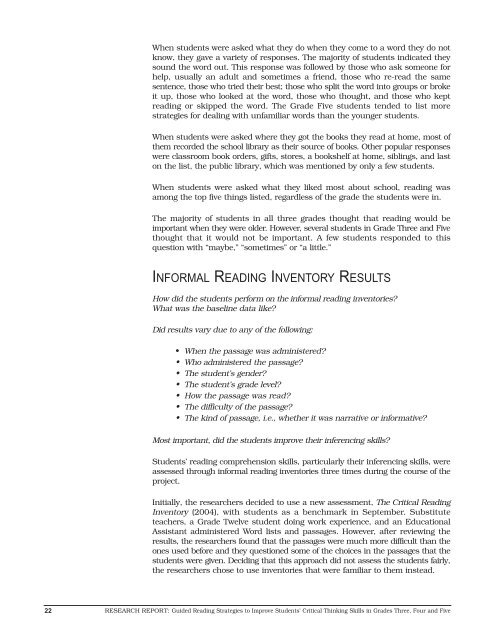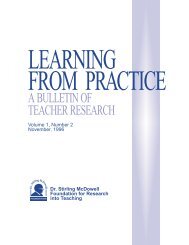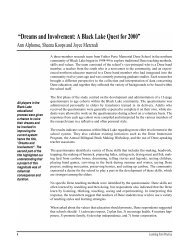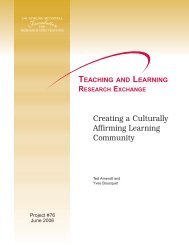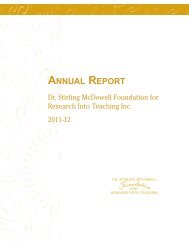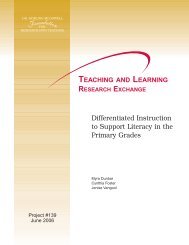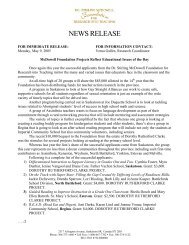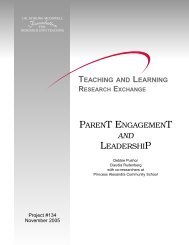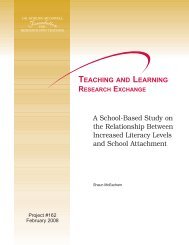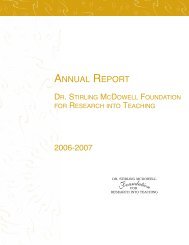Guided Reading Strategies to Improve Students - Dr. Stirling ...
Guided Reading Strategies to Improve Students - Dr. Stirling ...
Guided Reading Strategies to Improve Students - Dr. Stirling ...
- No tags were found...
Create successful ePaper yourself
Turn your PDF publications into a flip-book with our unique Google optimized e-Paper software.
When students were asked what they do when they come <strong>to</strong> a word they do notknow, they gave a variety of responses. The majority of students indicated theysound the word out. This response was followed by those who ask someone forhelp, usually an adult and sometimes a friend, those who re-read the samesentence, those who tried their best; those who split the word in<strong>to</strong> groups or brokeit up, those who looked at the word, those who thought, and those who keptreading or skipped the word. The Grade Five students tended <strong>to</strong> list morestrategies for dealing with unfamiliar words than the younger students.When students were asked where they got the books they read at home, most ofthem recorded the school library as their source of books. Other popular responseswere classroom book orders, gifts, s<strong>to</strong>res, a bookshelf at home, siblings, and las<strong>to</strong>n the list, the public library, which was mentioned by only a few students.When students were asked what they liked most about school, reading wasamong the <strong>to</strong>p five things listed, regardless of the grade the students were in.The majority of students in all three grades thought that reading would beimportant when they were older. However, several students in Grade Three and Fivethought that it would not be important. A few students responded <strong>to</strong> thisquestion with “maybe,” “sometimes” or “a little.”INFORMAL READING INVENTORY RESULTSHow did the students perform on the informal reading inven<strong>to</strong>ries?What was the baseline data like?Did results vary due <strong>to</strong> any of the following:• When the passage was administered?• Who administered the passage?• The student’s gender?• The student’s grade level?• How the passage was read?• The difficulty of the passage?• The kind of passage, i.e., whether it was narrative or informative?Most important, did the students improve their inferencing skills?<strong>Students</strong>’ reading comprehension skills, particularly their inferencing skills, wereassessed through informal reading inven<strong>to</strong>ries three times during the course of theproject.Initially, the researchers decided <strong>to</strong> use a new assessment, The Critical <strong>Reading</strong>Inven<strong>to</strong>ry (2004), with students as a benchmark in September. Substituteteachers, a Grade Twelve student doing work experience, and an EducationalAssistant administered Word lists and passages. However, after reviewing theresults, the researchers found that the passages were much more difficult than theones used before and they questioned some of the choices in the passages that thestudents were given. Deciding that this approach did not assess the students fairly,the researchers chose <strong>to</strong> use inven<strong>to</strong>ries that were familiar <strong>to</strong> them instead.22 RESEARCH REPORT: <strong>Guided</strong> <strong>Reading</strong> <strong>Strategies</strong> <strong>to</strong> <strong>Improve</strong> <strong>Students</strong>’ Critical Thinking Skills in Grades Three, Four and Five


